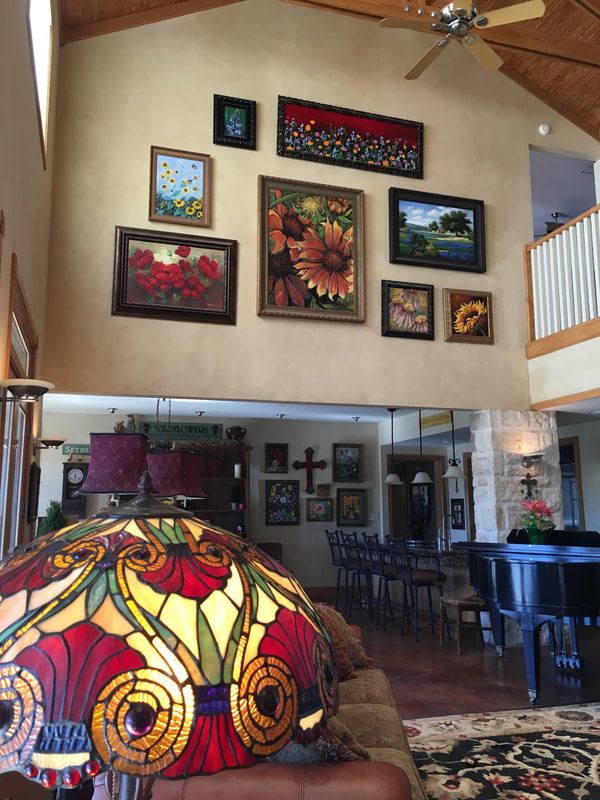|
"True Bliss," 12x12 acrylic © 2021 Linda Calvert Jacobson, shown unframed and then in mock-ups with wooden and golden frames. "The Aspens are Calling," 36x60 acrylic © Linda Calvert Jacobson. A "floater" frame like this gives a large painting a contemporary, finished look without distracting from the art itself. A question I often hear when someone is considering a purchase of my art is whether or not they should have it framed. Generally, my answer is that since the paintings are on on gallery wrap canvas with the colors continuing around the edges, they do not require framing. However, I'm quick to add, it is entirely up to the collector! For larger paintings, I often suggest that they consider a "floater" frame, which is how I have framed "The Aspens are Calling" shown here. It adds a finished look but has some space between the canvas and frame so you can still see the painted edges. Not only is it very contemporary in style, it creates the illusion of the painting "floating" in the frame.
Most buyers do not frame my paintings but I love seeing how it looks when they do. I've posted some photos below that collectors have been kind enough to send me. As you can see, the framing changes not only the look of the art but also the impact it has has on the wall. For these settings, it gives the paintings more of a prominence while creating unity with the other objects in the room. Not knowing where one of my paintings would end makes it nearly impossible for me to choose a frame before it is sold. Which is why I leave it up to the collector so they can match not only their decor, but also their own personal taste. With that said, here are a few tips I would suggest you consider when you looking at framing any of my paintings. First, look at other furnishings in the room. If you tend to have a lot of dark, natural wood then you may want to pick something similar for the painting. A good example of this are the first two photos here, "Bluebonnet Delight" and "Butterscotch Haze." Another consideration is the color of the wall. If you want the painting to stand out more, setting it off with a frame can make that happen. "Amarillo Sky" in the third photo is a great example of using a frame with a fillet, a section of molding that fits between the frame and the painting, to help make the painting pop. Of course, you need to consider what other art you have in the room and how to create a cohesive look. The collector of my "Don't Fence Me In" and "Prickly Poppy Paradise" chose to frame both paintings, which created both balance and unity for her display. As you see in the final two photos, framing "Crimson Tapestry" (top center of the photos) was necessary for it to fit with the wildflower-themed gallery wall of various framed paintings by different artists that this client has created in her home. Finally, try different frames on the painting to see how it looks. If you have the ability to do so, you can even create a mock-up with photo-editing software like I've done with "True Bliss" one of my poppy paintings at the top of this blog. If that's something you can't do but you're interested, I might be able to help you out! Let me know which painting you are considering and we can go from there. So, to frame or not to frame? Like the selecting art itself, is a personal decision that only you can make. Comments are closed.
|
Recent Posts
April 2023
Blogger Archives
|
- Home
-
Art
- Small Wildflower Paintings (sizes up to 30x12)
- Even Smaller Wildflower Paintings (sizes up to 12x12)
- Mid-Size Wildflower Paintings (up to 24x36)
- Large Wildflower Paintings (up to 30x40)
- X-Large Wildflower Paintings (36x48 and up)
- Wildflower and Sunrise/Sunset Landscapes
- Motley Meadows
- Poppies and Other Flowers
- Aspen and Fall Landscapes
- About
- Services
- Testimonials
- Contact
- Visit
- Blog
- Archives
Visit Wildflower Art Gallery in the beautiful Texas Hill Country!
|
Contact UsLinda Calvert Jacobson, American Artist
[email protected] 830-221-7676 David A. Jacobson, Wildflower Art Gallery Manager [email protected] 830-730-7880 Subscribe
|








 RSS Feed
RSS Feed
